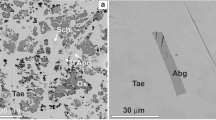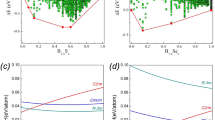Abstract
CHALCOPHANITE crystallizes in the triclinic system, space group P&1bar;, with a = 7.54, b = 7.54, c = 8.22 A., α = 117.2°, β = 90°, γ = 120°. The crystal structure was determined by Fourier methods of X-ray analysis on a specimen from the U.S. National Museum, Smithsonian Institution.
This is a preview of subscription content, access via your institution
Access options
Subscribe to this journal
Receive 51 print issues and online access
$199.00 per year
only $3.90 per issue
Buy this article
- Purchase on Springer Link
- Instant access to full article PDF
Prices may be subject to local taxes which are calculated during checkout
Similar content being viewed by others
References
Yü and Beevers, Z. Krist., 95, 426 (1936).
“Dana's System of Mineralogy”, seventh edit., 1, 739 (1944).
Frondel (private communication).
Author information
Authors and Affiliations
Rights and permissions
About this article
Cite this article
WADSLEY, A. Interstitial Atoms in the Layer Structure ZnMn3O73H2O (Chalcophanite). Nature 172, 1103–1104 (1953). https://doi.org/10.1038/1721103b0
Issue Date:
DOI: https://doi.org/10.1038/1721103b0
This article is cited by
Comments
By submitting a comment you agree to abide by our Terms and Community Guidelines. If you find something abusive or that does not comply with our terms or guidelines please flag it as inappropriate.



